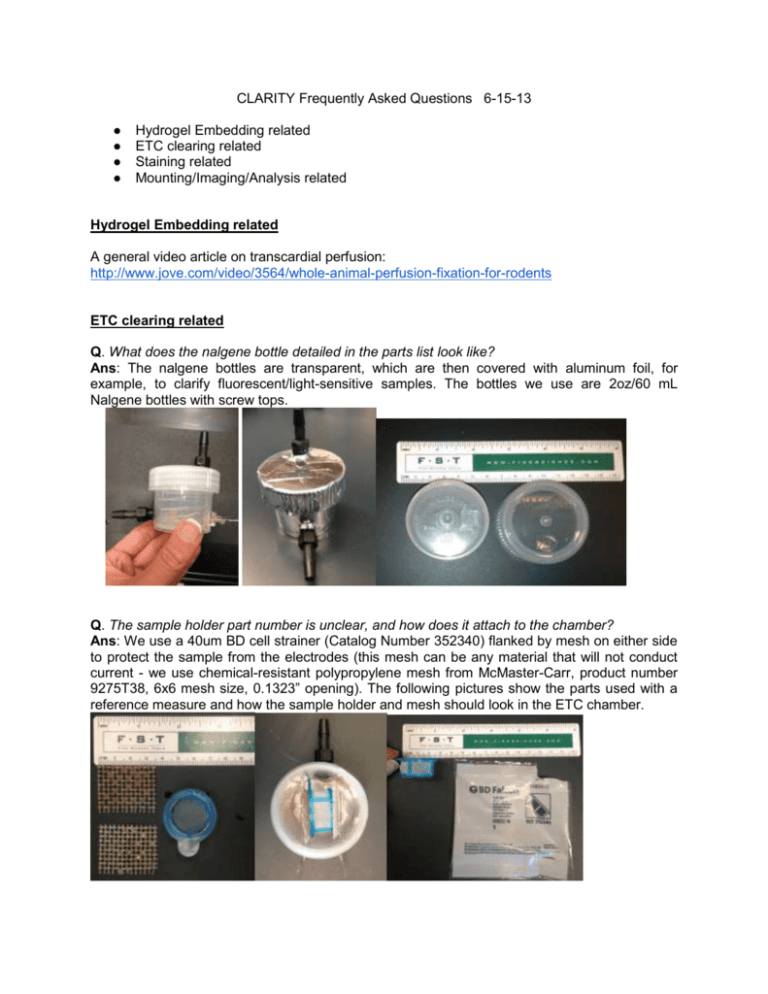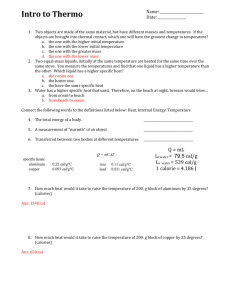CLARITY_faq_6-15
advertisement

CLARITY Frequently Asked Questions 6-15-13 ● ● ● ● Hydrogel Embedding related ETC clearing related Staining related Mounting/Imaging/Analysis related Hydrogel Embedding related A general video article on transcardial perfusion: http://www.jove.com/video/3564/whole-animal-perfusion-fixation-for-rodents ETC clearing related Q. What does the nalgene bottle detailed in the parts list look like? Ans: The nalgene bottles are transparent, which are then covered with aluminum foil, for example, to clarify fluorescent/light-sensitive samples. The bottles we use are 2oz/60 mL Nalgene bottles with screw tops. Q. The sample holder part number is unclear, and how does it attach to the chamber? Ans: We use a 40um BD cell strainer (Catalog Number 352340) flanked by mesh on either side to protect the sample from the electrodes (this mesh can be any material that will not conduct current - we use chemical-resistant polypropylene mesh from McMaster-Carr, product number 9275T38, 6x6 mesh size, 0.1323” opening). The following pictures show the parts used with a reference measure and how the sample holder and mesh should look in the ETC chamber. Q. Do you need to seal between the lid and the body of ETC chamber? Ans: The bottle lid itself provides a water-tight seal. It is important to make the inlet, outlet and electrode fittings water-tight. Q. How far apart are the electrodes inside the chamber? Ans: The details are provided in the Supplementary figure 2. As a rule of thumb, we use the lid of 50 ml falcon tube to separate the electrodes as it is close to the cell strainer + mesh width. Q. The specified electrode fitting holders have an ID (1.587mm) three times bigger than the electrode wire width (0.5mm). How does the electrode wire remain fixed, and how is it sealed? Ans: We fix the Platinum electrode wire to holders by filling the remaining holder space and surrounding fitting with epoxy solution. The epoxy and dispenser is in the materials inventory and should be used at all inlet/outlet and electrode fitting junctures. Allow to dry overnight for a liquid-tight seal. Q. Which end of the platinum wire electrode in the chamber connect to power supply? Ans: The bottom ends, which are protruding through to the outside of the chamber. Q. Does the Platinum wire hold its E-shape and the angle at its entry-point? Ans: Yes, it does. Q. Can both the inlet/outlet and electrode tube fittings vary in appearance? Ans: There are many ways to build the ETC. For convenience, we often use pre-made parts from McMaster-Carr and Nalgene, which therefore need not exactly mirror some diagrams. These are all listed in the materials inventory. Q. The ETC bottle inlet port is not capped. How does the fluid stay inside? Ans: The inlet ports are connected by sealed tubing, which connect to the buffer filter and buffer circulator in the following order: Buffer circulator outlet --(tubing)--> stopcock --(tubing)--> Buffer filter inlet --(filter interior)-> Buffer filter outlet --(tubing)--> stopcock --(tubing)--> ETC chamber inlet(bottom) --(ETC interior)--> ETC chamber outlet (top) -->--(tubing)--> stopcock --(tubing)--> Buffer circulator inlet --(Buffer Circulator Interior)--> Buffer circulator outlet Note that both the ETC inlets/outlets (7/16” hex) and the filter inlets/outlets (9/16” hex) are made of the single barbed tube fittings listed in the inventory. Q. How to scale clearing time, voltages and electrode spacing to clarify larger samples, eg rat brain. Ans: In general, the higher the voltage or smaller the separation, higher the electric force and hence lesser clearing time. However, high voltage can adversely affect the tissue integrity. We suggest remaining under 20 V. Q. For your ETC chamber, is it acrylic, stainless steel, or some other material? Ans: We custom-build our ETC chamber. We use a plastic nalgene screw-top bottle as the base chamber, add plastic single barbed tube fittings as the inlet and outlet, and tube-to-tube couplings for electrode inserts with platinum wires bent to shape as electrodes. All of the parts we use are listed in the materials inventory, and pictures are provided within. However please note, there are many ways to apply a voltage with temperature controlled buffer circulation, and the gel electrophoresis chamber is one. Q. Can you daisy chain several chambers to the same circulator? If so, are they connected serially, or in parallel to the water bath with several pumps? Ans: Yes, parallel connections work well. Q. In the protocol, it is recommended to use a water bath with external circulation that has both cooling and heating capabilities. Is the cooling necessary to achieve a 37°-50° temperature? Is it possible to use a pump coupled with simple heating water bath? Ans: Normally electrophoresis produces heat, and hence the temperature of the buffer may rise above the set point. Cooling will be needed to bring it to set point again. However, it is possible to avoid cooling by running buffer at lower than set temperature to compensate for the heating. It is possible to use a pump coupled with simple heating water bath. Q. Because of the large volume needed, and the cost of SDS, can you reuse the clearing solution for several runs? Ans: Clearing solution is extremely important for the success of ETC based clearing. The pH and ionic concentrations are critical parameters. Typically, clearing solution can be re-used as long as the pH and buffer chemistry are not changing. Make sure to check pH regularly to make sure it has not changed from 8.5 due to electrolysis within the ETC chamber. Rebalancing pH is not a good idea as it will change ionic strength of the buffer. We usually replace the clearing solution (in circulator) and water filter cartridge (in buffer filter) every 2-3 whole mouse brain samples. Q. In the protocol it says that two setups can be run at 50 degC and 60V while four setups can be run at 37 degC and 30V. Is this because the power supply can not maintain 60V across four setups? How is the temperature related to the voltage? Ans: It is correct that the power supply can not maintain 60V across four setups. In general, it is better to use lower temperatures (such as 37 degC) and lower voltages (10-30V) in order to maintain the pH of the buffer solution and reduce the number of bubbles that form in the solution during clearing. Higher voltages and temperatures lead to increased electrolysis at the electrodes, which leads to bubble formation and changes to the composition of the clearing solution. Both of these changes could be damaging to the tissue. Q. Do you need more than one buffer filter for multiple simultaneous ETC chambers? How long does the filter cartridge last? Ans: Only one filter per circulator, but the filter cartridge is replaced after every 2 whole brain samples. Q. Sometimes I see black carbonaceous material appearing on my sample. Ans: This can arise from black tubing, oxidized tissue, or blackened/burned connectors on the circulator. Use clear tubing and if the problem is persistent use an all-stainless steel circulator like the Julabo. Staining related Q. The protocol does not indicate the use of a blocking reagent prior to the primary antibody incubation, or during the primary and secondary incubations such as serum or BSA. Is it specific to immunostaining done in your study, or is it not necessary due to the “hydrogel” nature of the tissue? Ans: Blocking-reagent incubation of hydrogel tissue may be done but is often not necessary as the most unspecific binding sites / pockets are already removed in the clearing process. Q. For the multiple-round immunostaining, could you detail the incubation times used to wash the imaging solution? Ans: The imaging media can be removed by incubating the tissue two times in PBS (50 ml Falcon, with shaking) for one day each. Q. VA044: I can’t seem to find any place to purchase it. Ans: Please refer to protocol on the website http://clarityresourcecenter.org. Inventory: http://clarityresourcecenter.org/CLARITY_materials.pdf VA044 can be purchased from Wako (Cat. no. VA-044). Additionally we recommend FocusClear from CelExplorer. Mounting/Imaging/Analysis related Q. How to best store the samples for future analysis? Ans: The embedded samples can be stored in PBS-TritonX @ 4 degrees celsius. The cleared samples can be stored in FocusClear medium at room temperature. Take care to lightproof samples if necessary. Q. In the final refractive index matching step, glycerol and FocusClear are reported to be interchangeable, but then only FocusClear is recommended for filling the imaging chamber. Why? And is it possible to use a 80-85% glycerol solution instead of FocusClear for filling? Ans: We have found that FocusClear gives the best clearing results. 80-85% glycerol also can work but not as well since it does not match well with the tissue refractive index. Please refer to Supplementary Figure 3 for a comparison. Q. Are the Willco dishes reusable? Ans. The dishes are not reusable. Q. Which confocal, including stage and objectives, did you use for image acquisition? Ans: Leica SP5 equipped with 10X HCX AOP L (water immersion, 0.3 NA, 3.6 mm working distance), 25X HCX IRAPOL (water immersion, 0.95 NA, 2.4 mm working distance), 63X (1.3 NA, glycerol-immersion, working distance 280 microns) and an encoded automated stage recommended by Leica. Q. Could you provide specs of the control computer used for data acquisition? Ans: Should be tuned to microscope manufacturer recommendations, with an excellent graphics card, and extensive RAM and storage corresponding to dataset size (see below). Q. What are the specs of the computer you used for analyzing images with Imaris? How much storage capacity for raw and processed data is needed? Ans: In general any computer with multiple cores of latest CPUs, a large amount of RAM (>=64 GB), an excellent graphics card and ample storage capacity will work. For mouse imaging experiments, depending on the objectives used, data sets can reach up to several hundreds of GBs. Thus, we recommend corresponding storage, depending on the number of experiments.








